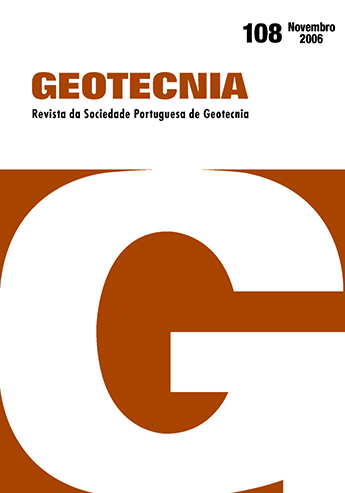Landslides risk maps and insurance plans in Brazil: an essay in Caraguatatuba (SP)
DOI:
https://doi.org/10.14195/2184-8394_108_11Abstract
The paper presents the main results related to a research on landslide risk mapping that applies quantitative models for risk evaluation. It also discusses the use of these risk maps as a technical base for insurance plans in order to reduce the economic and social consequences of landslide hazards in Brazilian urban areas. The proposed method for landslide risk mapping comprises three main steps: Inventory, Hazard Analysis and Risk. The Geographic Information System - GIS was used as basic tool for the record, analysis and mapping in all these steps. The research also comprised an application essay in a pilot area, located in Caraguatatuba, São Paulo State.
Downloads
References
Arnould, M. Geological hazards – insurance and legal and technical aspects. Bulletin of the Inter national Association of Engineering Geology, n.14, p.263-274. 1976.
Augusto Filho, O. Carta de risco de escorregamentos quantificada em ambiente de SIG como subsídio para planos de seguro em áreas urbanas: um ensaio em Caraguatatuba (SP). Tese de doutorado, Instituto de Geociências e Ciências Exatas – UNESP, Rio Claro. 196p. 2001.
Campbell, R. H.; Bernknopf, R.L.; Soller, D. R. Mapping time-dependent changes in soil-slip debris-flow probability. US Geological Survey Open-File Report in press. 16p. 1999.
Carvalho, C. S. & Hachich, W. Quantitative risk analysis of urban slopes: an application of subjective probability. Proc. of the Eighth Congress of the International Association for Engineering Geology and Environment - IAEG. Vancouver. A.A. Balkema. vol.2, p.887-890. 1998.
Carvalho, C.S. Estudo da infiltração em encostas de solos insaturados na Serra do Mar. São Paulo. Dissertação de mestrado, Escola Politécnica - Universidade de São Paulo. 150p. 1989.
Einstein, H.H. Landslide risk – systematic approaches to assessment and management. In: Cruden & Fell (ed.), Landslide risk assessment. Proc. of the International Workshop on Landslide Risk Assessment. Hawaii. A.A. Balkema. p.25-49. 1997.
Einstein, H.H. & Karan, K.S. Risk assessment and uncertainties. Proc. of International Conference on Landslides – Causes, Impacts and Countermeasures. Davos. VGE. p.457-488. 2001.
Fell, R. Landslide risk assessment. Proc. of Second Symposium on Risk Assessment in Geotechni cal & Geo-Environmental Engineering. Alberta. Geotechnical Society of Edmonton: p. 1 –19. 1996.
Finlay, P.J. & Fell, R. Landslides: risk perception and acceptance. Canadian Geotechnical Journal. vol. 34, n. 2. April. p.169-188. 1997.
Gama, C.D. Avaliações probabilísticas da estabilidade de taludes. Anais do Sétimo Congresso Brasileiro de Mecânica dos Solos. Recife. ABMS. v. 1, p.59-74. 1982.
Gumbel, E.J. Statistics of extremes. Columbia University Press, New York, 375 p.1958.
Hartlén, J. & Viberg, L. Evaluation of landslide hazard. Proc. of Fifth International Symposium on Landslides. Lausanne. A.A. Balkema. v.2, p. 1038-1057. 1988.
Hutchinson, D.J.; Harrap, R.; Ball, D.; Diederichs, M.; Kjelland, N. Development of geotechnical sensor network analysis capabilities for slope stability monitoring, within a GIS based decision support system. Proc. of Ninth International Symposium on Landslides. Rio de Janeiro. A. A. Balkema. v1, p.759-765. 2004.
International Union of Geological Sciences - IUGS - Committee on Risk Assessment Quantitative risk assessment for slopes and landslides – the state of the art. In: Cruden & Fell (ed.), Landslide risk assessment. Proceedings of the International Workshop on Landslide Risk Assessment. A.A. Balkema. p.3-14. 1997.
Jibson, R. W.; Harp, E.L.; Michael J.A. A method for producing digital probabilistic seismic landslide hazard: an example from the Los Angeles, California, Area. U.S. Geological Survey Open-File 98-113. 1998.
Lumb, P. Slope failures in Hong Kong. Quarterly Journal of Engineering Geology, v. 8, p. 31-65. 1975.
Macedo, E. S.; Ogura, A.T.; Santoro, J. Landslide warning system in Serra do Mar slopes. Proc. of the Eighth Congress of the International Association for Engineering Geology and Environment - IAEG. Vancouver. A.A. Balkema. vol.2, p.1967-1971. 1998.
Smolka A. & Berz, G. Methodology of hazard mapping – requirements of the insurance industry. Bulletin of the International Association of Engineering Geology - IAEG, n.23, p.21-24. 1981.
Terlien, M.T.J.; Westen, C.J.V.; Asch, W.J.V. Deterministic modeling in GIS-based landslide hazard assessment. In: Carrara & Guzzetti (ed.), Geographical Information Systems in assessing natural hazards. Kluwer Academic Publishers. p.57-78. 1995.
Van Westen, C.J. Geo-information tools for landslide risk assessment: an overview of recent developments. Proc. of Ninth International Symposium on Landslides. Rio de Janeiro. A. A. Balkema. v1. p.39-56. 2004.
Varnes, D.J. et al. Landslide hazard zonation: a review of principles and practice. UNESCO. 63p. Paris. 1985.
Wilson R.C. & Jayko, A.S. Preliminary maps showing rainfall thresholds for debris-flow activity, San Francisco Bay region, CA. US Geological Survey Open-File Report 97-745 F. 1997.
Wolle, C.M. Taludes naturais: mecanismos de instabilização e critérios de segurança. Tese de doutorado, Escola Politécnica - Universidade de São Paulo. 245p. 1980




